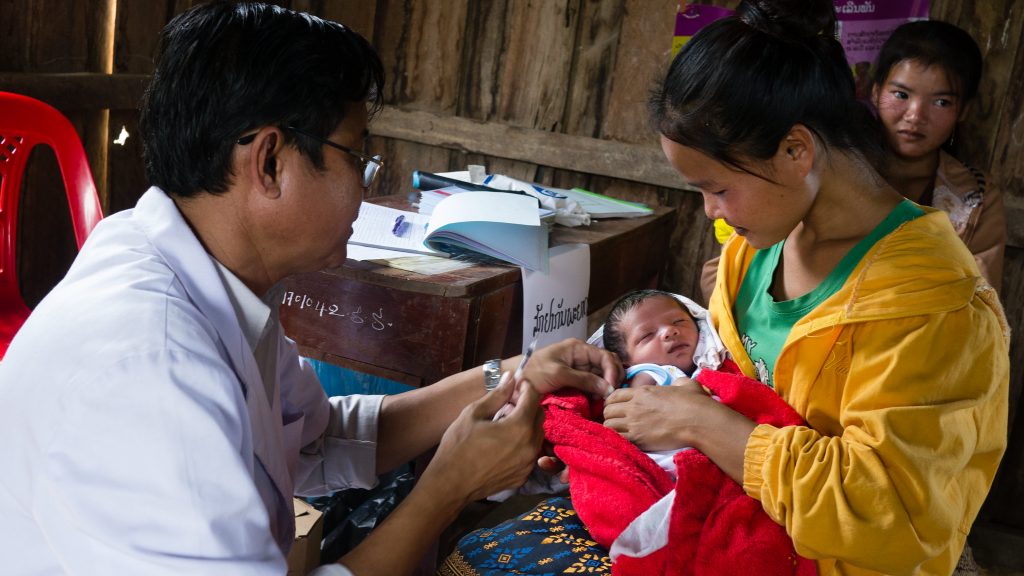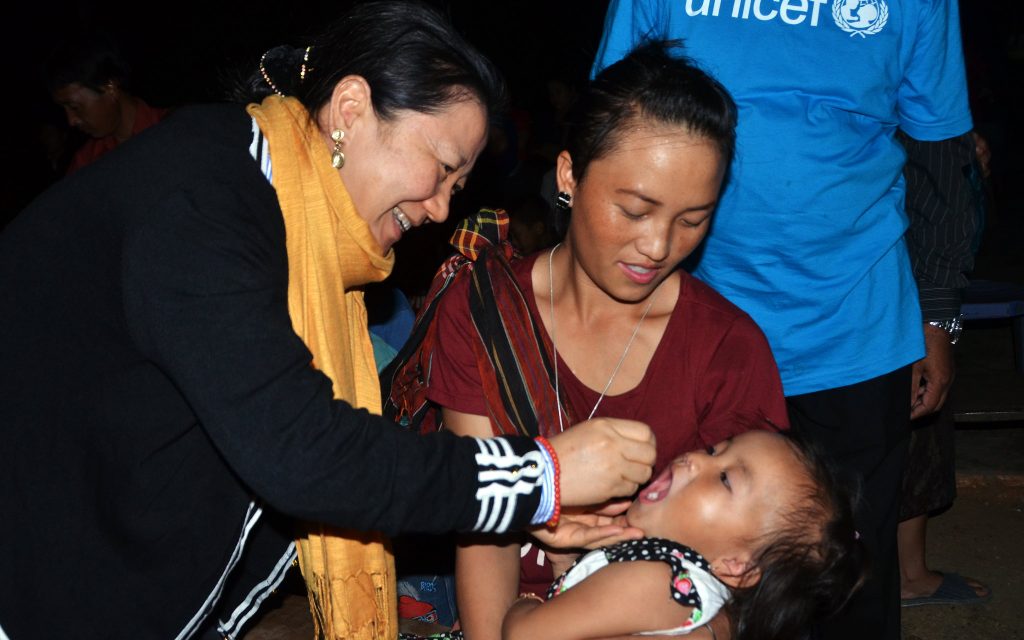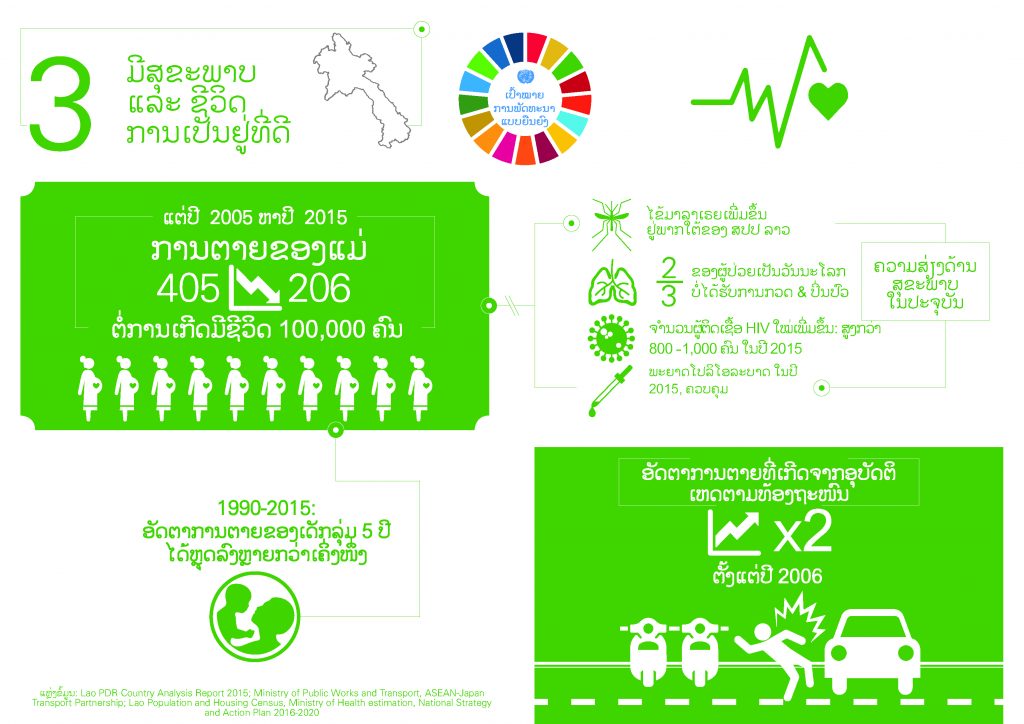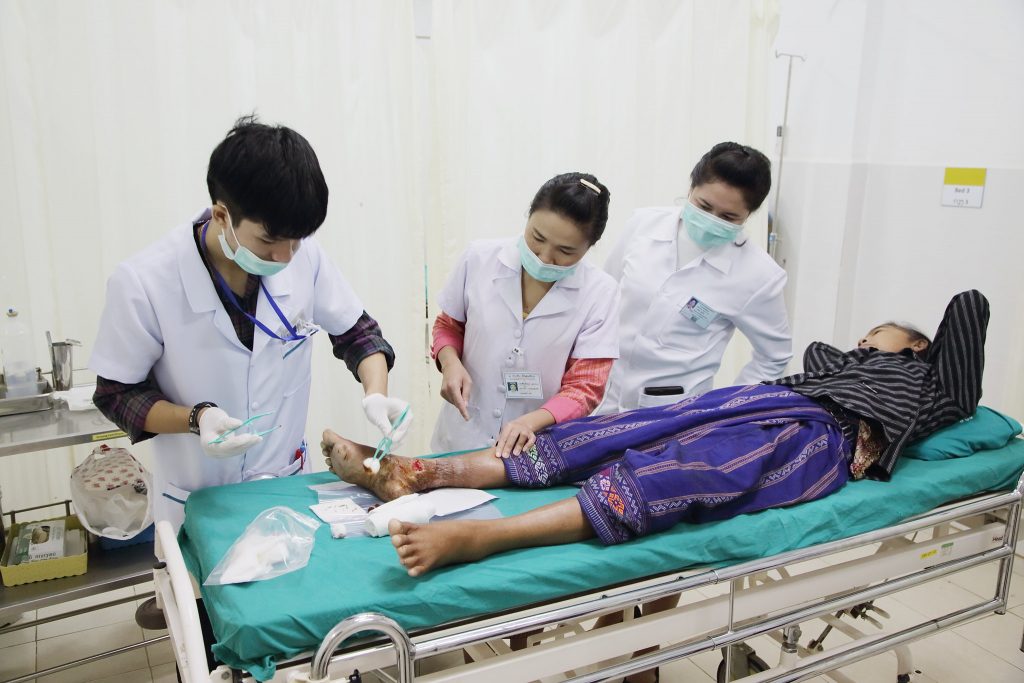ເປົ້າໝາຍການພັດທະນາແບບຍືນຍົງທີ 3 (SDG 3) – ‘ມີສຸຂະພາບ ແລະ ຊີວິດການເປັນຢູ່ທີ່ດີ’ ແມ່ນແນໃສ່ຮັບປະກັນດ້ານສຸຂະພາບທີ່ແຂງແຮງ ແລະ ສົ່ງເສີມຊີວິດການເປັນຢູ່ທີ່ດີສຳລັບທຸກຄົນໃນທຸກໆລະດັບອາຍຸ.1 SDG 3 ລວມມີ 13 ເປົ້າໝາຍ, ແລະ 26 ຕົວຊີ້ວັດໃນການຕິດຕາມ. ເປົ້າໝາຍທີ 3.1, 3.5 & 3.7 ແມ່ນເພື່ອຫຼຸດຜ່ອນອັດຕາການຕາຍຂອງແມ່ ແລະ ສົ່ງເສີມສຸຂະພາບຂອງແມ່, ເພດສຳພັນ ແລະ ໄວຈະເລີນພັນ, ສ່ວນເປົ້າໝາຍ 3.2 ແນໃສ່ຫຼຸດຜ່ອນອັດຕາການຕາຍຂອງເດັກເກີດໃໝ່, ເດັກອ່ອນ ແລະ ເດັກອາຍຸຕ່ຳກວ່າຫ້າປີ. ເປົ້າໝາຍ 3.3 ແລະ 3.4 ແມ່ນເພື່ອປັບປຸງການຄວບຄຸມພະຍາດ HIV, ວັນນະໂລກ, ໄຂ້ປ່າ, ພະຍາດຕິດແປດ ແລະ ພະຍາດບໍ່ຕິດແປດຕ່າງໆ. ເປົ້າໝາຍ 3.5 ແລະ 3.A ແມ່ນກ່ຽວກັບການຄວບຄຸມການນຳໃຊ້ທາດເສບຕິດຕ່າງໆ ເຊັ່ນ ເຫຼົ້າ, ຢາສູບ, ແລະ ຢາເສບຕິດປະເພດຕ່າງໆ; ແລະ ເປົ້າໝາຍ 3.6 ແລະ 3.9 ແມ່ນແນໃສ່ເພື່ອຫຼຸດຜ່ອນອັດຕາການບາດເຈັບ ແລະ ອັດຕາການຕາຍຈາກອຸບັດຕິເຫດ ແລະ ຈາກສານເຄມີ ແລະ ມົນລະພິດ ແລະ ສິ່ງປົນເປື້ອນທາງສິ່ງແວດລ້ອມ. ເປົ້າໝາຍ 3.8, 3.C ແລະ 3.D ແມ່ນແນໃສ່ສົ່ງເສີມລະບົບຄຸ້ມຄອງຄຸນນະພາບ ແລະ ບັນລຸເປົ້າໝາຍການຄຸ້ມຄອງສຸຂະພາບທົ່ວສັງຄົມ. ໃນຂະນະທີ່ເປົ້າໝາຍ 3.B ແມ່ນເພື່ອສ້າງຄວາມຍືນຍົງດ້ານການຄົ້ນຄວ້າ ແລະ ການພັດທະນາ ຢາວັກຊີນປ້ອງກັນພະຍາດ ແລະ ຢາຕ່າງໆ ເພື່ອຮັບປະກັນການເຂົ້າເຖິງ ແລະ ຄວາມສາມາດໃນການນຳໃຊ້ໃຫ້ທົ່ວເຖິງ.2
ຈາກເປົ້າໝາຍການພັດທະນາແຫ່ງສະຫະສະວັດສູ່ SDG 3
ເປົ້າໝາຍການພັດທະນາແຫ່ງສະຫະສະວັດ (MDGs) ແມ່ນເປົ້າໝາຍການພັດທະນາໂລກເຊິ່ງມີການຮັບຮອງເອົາໃນປີ 2000, ແລະ ມີຄາດໝາຍສູ້ຊົນໃຫ້ສຳເລັດໃນປີ 2015 ເພື່ອເປັນແນວທາງການພັດທະນາສຳລັບລັດຖະບານ ແລະ ບັນດາຄູ່ຮ່ວມພັດທະນາ. MDGs ລວມມີ 8 ເປົ້າໝາຍການປະຕິບັດ ເຊິ່ງມີຈຸດປະສົງແນໃສ່ລຶບລ້າງຄວາມທຸກຍາກ ແລະ ຍົກລະດັບມາດຕະຖານການດຳລົງຊີວິດໃນທົ່ວໂລກ. MDGs ແນໃສ່ການພັດທະນາວຽກງານການສຶກສາ, ຄວາມສະເໝີພາບທາງເພດ, ສຸຂະພາບ, ສິ່ງແວດລ້ອມ ແລະ ການຮ່ວມມືສາກົນ. ກ່ອນສິ້ນສຸດວາລະໃນການຈັດປະຕິບັດ MDGs ໃນປີ 2015, ເປົ້າໝາຍການພັດທະນາແບບຍືນຍົງ (SDGs) ໄດ້ຮັບການສ້າງຂຶ້ນເພື່ອສານຕໍ່ຜົນສຳເລັດ ແລະ ສິ່ງທ້າທາຍໃນການປະຕິບັດ MDGs. ໂດຍການເສີມຂະຫຍາຍ MDGs ທີ່ສ່ວນໃຫຍ່ແມ່ນເນັ້ນໃສ່ການພັດທະນາທາງສັງຄົມ, SDGs ໄດ້ລວມເອົາທຸກໆຂົງເຂດການພັດທະນາແບບຍືນຍົງ ບໍ່ວ່າຈະເປັນດ້ານເສດຖະກິດ, ສັງຄົມ ແລະ ສິ່ງແວດລ້ອມ. SDGs ແມ່ນເປົ້າໝາຍການພັດທະນາລວມລະດັບໂລກ ທີ່ສາມາດນຳໃຊ້ໃນທຸກໆປະເທດໂດຍບໍ່ຈຳແນກລະດັບການພັດທະນາຂອງແຕ່ລະປະເທດ ເພື່ອກ້າວໄປສູ່ການພັດທະນາແບບຍືນຍົງຢ່າງແທ້ຈິງ.3

ການສັກຢາປ້ອງກັນພະຍາດສຳລັບເດັກນ້ອຍຢູ່ແຂວງອັດຕະປື, ສປປ ລາວ. ຮູບຖ່າຍໂດຍ Simon Nazer ວັນທີ 24 ຕຸລາ 2014. ລິຂະສິດພາຍໃຕ້ Simon Nazer
SDG 3 ແມ່ນກ່ຽວເນື່ອງມາຈາກເປົ້າໝາຍ MDG 4 ‘ການຫຼຸດຜ່ອນອັດຕາການຕາຍຂອງແມ່’, ເປົ້າໝາຍ MDG 5 ‘ການສົ່ງເສີມສຸຂະພາບຂອງແມ່’, ແລະ ເປົ້າໝາຍ MDG 6 ‘ການຄວບຄຸມພະຍາດ HIV/AIDS, ໄຂ້ປ່າ ແລະ ພະຍາດອື່ນໆ’. ນອກຈາກນີ້ ເປົ້າໝາຍ SDG 3 ຍັງລວມເອົາເປົ້າໝາຍກ່ຽວກັບພະຍາດຕິດຕໍ່ ແລະ ພະຍາດບໍ່ຕິດຕໍ່ (NCDs), ອຸບັດຕິເຫດ, ການນຳໃຊ້ສິ່ງເສບຕິດ, ແລະ ສຸຂະພາບຈິດ ພາຍໃຕ້ການເພີ່ມຂຶ້ນຂອງອັດຕາການຕາຍ, ການເຈັບປ່ວຍ ແລະ ການເກີດອຸບັດຕິເຫດໃນອັດຕາການຕາຍລວມໃນປະເທດທີ່ກຳລັງພັດທະນາ.4
ກ່ຽວກັບເປົ້າໝາຍ MDG 4, ສປປ ລາວສາມາດບັນລຸເປົ້າໝາຍແຫ່ງຊາດກ່ຽວກັບການຫຼຸດຜ່ອນອັດຕາການຕາຍຂອງເດັກອາຍຸຕ່ຳກວ່າຫ້າປີມາເປັນ 67/1,000 ປະຊາກອນໃນປີ 2015, ຈາກ 170/1,000 ປະຊາກອນໃນປີ 1993. ລາວຍັງໄດ້ບັນລຸເປົ້າໝາຍແຫ່ງຊາດກ່ຽວກັບການຫຼຸດຜ່ອນອັດຕາການຕາຍຂອງເດັກມາເປັນ 45/1,000 ປະຊາກອນໃນປີ 2015, ຈາກ 114//1,000 ປະຊາກອນໃນປີ 1993. ເຖິງຢ່າງໃດກໍຕາມ ສປປ ລາວບໍ່ສາມາດບັນລຸເປົ້າໝາຍສາກົນກ່ຽວກັບການຫຼຸດຜ່ອນອັດຕາການຕາຍຂອງເດັກໃຫ້ເຫຼືອໜຶ່ງໃນສາມຂອງອັດຕາໃນປີ 1990. ການຫຼຸດຜ່ອນອັດຕາການຕາຍຂອງເດັກແມ່ນກ່ຽວຂ້ອງກັບອັດຕາສ່ວນຂອງເດັກທີ່ໄດ້ຮັບພູມຄຸ້ມກັນພະຍາດ. ອັດຕາການຄອບຄຸມຂອງການໃຫ້ຢາປ້ອງກັນພະຍາດແມ່ນເພີ່ມຂຶ້ນຢ່າງຕໍ່ເນື່ອງ, ແຕ່ກໍ່ຍັງບໍ່ທັນສາມາດບັນລຸເປົ້າໝາຍ MDG ຄື 90%. ອັດຕາການຄອບຄຸມການໃຫ້ຢາປ້ອງກັນພະຍາດໝາກແດງແມ່ນເພີ່ມຂຶ້ນເປັນ 79.5% ໃນປີ 2015; ຢາປ້ອງກັນພະຍາດ DTP-Hep3 (ຄໍຕີບ, ໄອໄກ່, ບາດທະຍັກ, ຕັບອັກເສບ) ເພີ່ມເປັນ 66.3%; ແລະ ຢາປ້ອງກັນວັນນະໂລກ BCG ເພີ່ມເປັນ68.6%.5
ສປປ ລາວ ໄດ້ບັນລຸເປົ້າໝາຍທຳອິດຂອງ MDG 5 ກ່ຽວກັບການຫຼຸດຜ່ອນອັດຕາການຕາຍຂອງແມ່ລົງ 75%. ໃນປີ 2015 ອັດຕາການຕາຍຂອງແມ່ (MMR) ຄາດຄະເນແມ່ນຢູ່ທີ່ 197/100,000 ຄົນ, ຫຼຸດລົງຈາກອັດຕາ 1,660/100,000 ຄົນໃນປີ 1990.6 ເຖິງຢ່າງໃດກໍຕາມ, ອັດຕາການຕາຍຂອງແມ່ຂອງປະເທດລາວແມ່ນຍັງຄົງມີສູງ ທຽບກັບບັນດາປະເທດສະມາຊິກອາຊຽນ; ອັດຕາການຕາຍຂອງແມ່ຂອງປະເທດມຽນມາແມ່ນ 180/100,000 ປະຊາກອນ, ກຳປູເຈຍແມ່ນ 161/100,000, ຫວຽດນາມ 54/100,000, ແລະ ໄທມີພຽງ 24.6/100,000.7
ເຖິງວ່າອັດຕາການເກີດລູກໂດຍຊ່ຽວຊານຜະດຸງຄັນຈະເພີ່ມຂຶ້ນເປັນ 53.9% ໃນປີ 2015, ບັນລຸເປົ້າໝາຍ MDG, ແຕ່ວ່າອັດຕາສ່ວນແມ່ຍິງລາວໃນຫຼາຍແຂວງທີ່ຍັງຄົງຜະເຊີນບັນຫາໃນການເກີດລູກແມ່ນຍັງມີສູງ. ລາວສາມາດບັນລຸອັດຕາການຝາກທ້ອງຢ່າງໜ້ອຍໜຶ່ງຄັ້ງ ໄດ້ 91% ໃນປີ 2015, ແຕ່ວ່າອັດຕາການຝາກທ້ອງຢ່າງໜ້ອຍສີ່ຄັ້ງຍັງຕ່ຳ (ມີພຽງ 52.4% ໃນປີ 2015).8
ສຳລັບ MDG 6, ລາວມີ ອັດຕາຜູ້ຕິດເຊື້ອ HIV 0.29% ຂອງປະຊາກອນໃນປີ 2015, ສູງກວ່າອັດຕາໃນປີ 2010 ຄື 0.25% ເລັກນ້ອຍ, ແຕ່ກໍຍັງຕ່ຳກວ່າລະດັບ 0.5% ຂອງເປົ້າໝາຍ. ອັດຕາການປິ່ນປົວດ້ວຍຢາຕ້ານໄວຣັສ໌ (ART) ຍັງຕ່ຳ, ມີພຽງ 54.8% ຂອງຜູ້ທີ່ຕ້ອງການການປິ່ນປົວໃນປີ 2015. ລາວມີຄວາມຄືບໜ້າທີ່ດີກ່ຽວກັບການຄວມຄຸມພະຍາດໄຂ້ປ່າ. ອັດຕາການເກີດພະຍາດໄຂ້ປ່າຫຼຸດລົງຈາກ 10 ຄົນມາເປັນ 4.92 ຄົນຕໍ່ 100,000 ປະຊາກອນໃນລະຫວ່າງປີ 1990 ແລະ ປີ 2015 ຕາມລຳດັບ. ອັດຕາການຕາຍຍ້ອນພະຍາດໄຂ້ປ່າຫຼຸດລົງຈາກ 9 ຄົນມາເປັນ 0.03 ຄົນຕໍ່ 100,000 ປະຊາກອນ. ນອກນີ້ ລາວຍັງສາມາດບັນລຸເປົ້າໝາຍກ່ຽວກັບພະຍາດວັນນະໂລກ (TB). ອັດຕາການເກີດພະຍາດວັນນະໂລກ ຫຼຸດລົງເຫຼືອ 190/100,000 ຄົນ ແລະ ອັດຕາການແຜ່ເຊື້ອຫຼຸດລົງເຫຼືອ 462/100,000 ຄົນໃນປີ 2014. ອັດຕາສ່ວນຄວາມສຳເລັດໃນການປິ່ນປົວພະຍາດວັນນະໂລກໃນປີ 2015 ແມ່ນມີສູງ (87%).9 10

ການຢອດຢາປ້ອງກັນພະຍາດເປ້ຍລ່ອຍຢູ່ຊຽງຂວາງ. ຮູບຖ່າຍ ໂດຍ Polio Laos ວັນທີ 23 ທັນວາ 2015. ລິຂະສິດພາຍໃຕ້ Polio Laos
ໂດຍລວມແລ້ວ ລາວສາມາດປະຕິບັດເປົ້າໝາຍ MDGs ດ້ານສາທາລະນະສຸກໃນລະດັບໜຶ່ງ, ແຕ່ກໍຍັງມີຫຼາຍວຽກງານທີ່ຍັງຕ້ອງສືບຕໍ່ປັບປຸງໃນຕໍ່ໜ້າ. ເພື່ອສືບຕໍ່ການພັດທະນະຂະແໜງສາທາລະນະສຸກ ແລະ ສົ່ງເສີມສຸຂະພາບ ແລະ ຊີວິດການເປັນຢູ່ທີ່ດີໃນທົ່ວປະເທດ, ສປປ ລາວໄດ້ທຳການຫັນ SDG 3 ເຂົ້າສູ່ແຜນນະໂຍບາຍໃນການພັດທະນາພາຍໃນປະເທດ ເຊິ່ງສາມາດຈຳແນກເປັນ 8 ຂົງເຂດເປົ້າໝາຍຄື: i) ຫຼຸດຜ່ອນອັດຕາການຕາຍຂອງແມ່ ແລະ ປັບປຸງດ້ານສຸຂະພາບຂອງແມ່, ດ້ານເພດສຳພັນ ແລະ ໄວຈະເລີນພັນ (ເປົ້າໝາຍ 3.1 ແລະ 3.7); (ii) ຫຼດຸຜ່ອນອັດຕາການຕາຍຂອງເດັກເກີດໃໝ່, ເດັກອ່ອນ, ແລະ ເດັກອາຍຸຕ່ຳກວ່າຫ້າປີ (ເປົ້າໝາຍ 3.2); (iii) ປັບປຸງການຄວບຄຸມພະຍາດ HIV (ເປົ້າໝາຍ 3.3); (iv) ປັບປຸງການຄວບຄຸມພະຍາດວັນນະໂລກ, ໄຂ້ປ່າ ແລະ ພະຍາດຕິດຕໍ່ຊະນິດອື່ນໆ (ເປົ້າໝາຍ 3.3); (v) ປັບປຸງການຄວບຄຸມພະຍາດບໍ່ຕິດຕໍ່ NCDs (ເປົ້າໝາຍ 3.4); (vi) ປັບປຸງການຄວບຄຸມການນຳໃຊ້ສິ່ງເສບຕິດ,ເຊັ່ນ ເຫຼົ້າ, ຢາສູບ ແລະ ຢາເສບຕິດຕ່າງໆ (ເປົ້າໝາຍ 3.5 ແລະ 3.a); (vii) ຫຼຸດຜ່ອນອັດຕາການບາດເຈັບ ແລະ ລົ້ມຕາຍຍ້ອນອຸບັດຕິເຫດ (ເປົ້າໝາຍ 3.6); ແລະ (viii) ສ້າງຄວາມເຂັ້ມແຂງໃຫ້ແກ່ລະບົບສາທາລະນະສຸກ ແລະ ບັນລຸການຄຸ້ມຄອງດ້ານສຸຂະພາບໃນທົ່ວປະເທດ (ເປົ້າໝາຍ 3.8, 3.c ແລະ 3.d).11
ການຫັນ SDGs ເຂົ້າສູ່ນະໂຍບາຍພາຍໃນແມ່ນດຳເນີນໂດຍການລວມເປົ້າໝາຍດັ່ງກ່າວເຂົ້າກັບແຜນພັດທະນາເສດຖະກິດ-ສັງຄົມແຫ່ງຊາດ (NSEDP), ເຊິ່ງເປົ້າໝາຍ ແລະ ຕົວຊີ້ວັດຕ່າງໆໃນໂຄງສ້າງການຕິດຕາມ ແລະ ປະເມີນຜົນຂອງ NSEDP ແມ່ນມີການປັບໃຫ້ຖືກກັບໂຄງສ້າງຂອງ SDGs ເພື່ອສະດວກໃນການຈັດຕັ້ງປະຕິບັດ ແລະ ການຕິດຕາມແຜນເປົ້າໝາຍທັງສອງຢ່າງ.12
ສຳລັບ SDG 3, ຕົວຊີ້ວັດຂອງເປົ້າໝາຍດັ່ງກ່າວໄດ້ຖືກລວມເຂົ້າກັບເປົ້າໝາຍລວມຂອງແຜນພັດທະນາເສດຖະກິດ-ສັງຄົມແຫ່ງຊາດ ຄັ້ງທີ 8 2016-2020, ໂດຍສະເພາະແມ່ນເປົ້າໝາຍທີ 2, ຄາດໝາຍສູ້ຊົນທີ 4 – ການເຂົ້າເຖິງການບໍລິການດ້ານການປິ່ນປົວສຸຂະພາບທີ່ມີຄຸນນະພາບໃນທົ່ວປະເທດ. ເປົ້າໝາຍດັ່ງກ່າວແມ່ນແນໃສ່ການປັບປຸງ ແລະ ເສີມຂະຫຍາຍຄຸນນະພາບຂອງການບໍລິການສາທາລະນະສຸກໂດຍລວມ ເພື່ອຮັບປະກັນການເຂົ້າເຖິງການປິ່ນປົວສຸຂະພາບ ແລະ ການບໍລິການທາງດ້ານການແພດສຳລັບທຸກຄົນ; ສ້າງຄວາມເຂັ້ມແຂງດ້ານການຄຸ້ມຄອງການບໍລິການສາທາລະນະສຸກຢ່າງເປັນປົກກະຕິ ແລະ ຕໍ່ເນື່ອງ ໂດຍການປັບປຸງພື້ນຖານໂຄງລ່າງ ເພື່ອຮັບປະກັນການເຂົ້າເຖິງການບໍລິການສາທາລະນະສຸກສຳລັບທ້ອງຖິ່ນຊົນນະບົດທີ່ຫ່າງໄກ; ເພີ່ມທະວີຄວາມສາມາດໃນການປິ່ນປົວ ແລະ ການນຳໃຊ້ຢາປ້ອງກັນພະຍາດ ແລະ ນຳໃຊ້ເທັກໂນໂລຢີທີ່ເໝາະສົມ ໃນການຍົກສູງຄຸນນະພາບຂອງການບໍລິການສາທາລະນະສຸກ; ຮັບປະກັນຄວາມຍືນຍົງດ້ານການເງິນສຳລັບຂະແໜງສາທາລະນະສຸກ ໂດຍການເພີ່ມທະວີງົບປະມານ ແລະ ການລົງທຶນພາກລັດໃຫ້ກວ້າງຂວາງ ຄອບຄຸນການປະກັນສຸຂະພາບສຳລັບຊຸມຊົນ ແລະ ພາກເອກະຊົນ; ແລະ ເຜີຍແຜ່ຂໍ້ມູນຂ່າວສານດ້ານສຸຂະພາບ ແລະ ການບໍລິການ ໂດຍສະເພາະກ່ຽວກັບສຸຂະພາບໄວຈະເລີນພັນ ແລະ ການວາງແຜນຄອບຄົວ, ແລະ ວຽກງານສຸຂາພິບານ.13
ການຈັດຕັ້ງປະຕິບັດ SDG 3 ໃນລາວ
ໃນການຈັດຕັ້ງປະຕິບັດ SDG 3, ປະເທດລາວໄດ້ຕັ້ງເປົ້າບັນລຸເປົ້າໝາຍການຄຸ້ມຄອງດ້ານສາທາລະນະສຸກທົ່ວປະເທດພາຍໃນປີ 2025, ເຊິ່ງທຸກຄົນສາມາດເຂັ້າເຖິງການບໍລິການດ້ານສາທາລະນະສຸກທີ່ມີຄຸນນະພາບໂດຍປາສະຈາກຂໍ້ຈຳກັດດ້ານການເງິນຕ່າງ. ເພື່ອບັນລຸເປົ້າໝາຍດັ່ງກ່າວ, ປະເທດລາວໄດ້ດຳເນີນການປະຕິຮູບຂະແໜງສາທາລະນະສຸກ ໂດຍເນັ້ນໃສ່ຂົງເຂດບູລິມະສິດຕ່າງໆເຊັ່ນ: ການຍົກລະດັບຄວາມສາມາດໃຫ້ແກ່ເຈົ້າໜ້າທີ່ສາທາລະນະສຸກ, ການປັບປຸງການລົງທຶນດ້ານສາທາລະນະສຸກໂດຍອີງໃສ່ການຮ່ວມມືຈາກຫຼາຍຂະແໜງການ, ການສ້າງຄວາມເຂັ້ມແຂງດ້ານການບໍລິຫານ, ການຈັດຕັ້ງ ແລະ ການຄຸ້ມຄອງຂະແໜງການ, ການເພີ່ມທະວີການເຂົ້າເຖິງການບໍລິການສາທາລະນະສຸກ ແລະ ການຄຸ້ມຄອງສະຖານທີ່ພະຍາບານ, ແລະ ການສ້າງຄວາມເຂັ້ມແຂງດ້ານລະບົບຂໍ້ມູນຂ່າວສານສາທາລະນະສຸກ.14

ແຫຼ່ງທີ່ມາ: ອົງການສະຫະປະຊາຊາດປະຈຳ ສປປ ລາວ.
ຄຽງຄູ່ກັບການປະຕິຮູບຂະແໜງການເຖິງປີ 2025, ກໍຍັງມີບັນດາໂຄງການຕ່າງໆທີ່ຊ່ວຍໃນການສະໜັບສະໜູນການພັດທະນາຂະແໜງສາທາລະນະສຸກ, ຕົວຢ່າງເຊັ່ນ:
ທະນາຄານພັດທະນາອາຊີ (ADB) ສະໜັບສະໜູນໂຄງການຊ່ວຍເຫຼືອໃນການຄຸ້ມຄອງຂະແໜງສາທາລະນະສຸກ ເປັນຈຳນວນ US$ 15 ລ້ານໂດລາໃນລະຫວ່າງປີ 2016 ເຖິງປີ 2020. ໂຄງການນີ້ຕົ້ນຕໍແມ່ນແນໃສ່ສ້າງຄວາມເຂັ້ມແຂງໃນການກະກຽມການຄຸ້ມຄອງບໍລິຫານຂະແໜງສາທາລະນະສຸກ ເພື່ອຮັບປະກັນການບໍລິການດ້ານສາທາລະນະສຸກພື້ນຖານ ແລະ ມີຄຸນນະພາບໃຫ້ແກ່ພົນລະເມືອງສ່ວນຫຼາຍ, ໂດຍສະເພາະແມ່ນແມ່ ແລະ ເດັກ. ນອກເໜືອຈາກການເຂົ້າເຖິງການບໍລິການ, ໂຄງການດັ່ງກ່າວກໍຍັງແນໃສ່ສະໜັບສະໜູນການປັບປຸງການຄຸ້ມຄອງການລົງທຶນໃນຂະແໜງສາທາລະນະສຸກ ແລະ ການພັດທະນາຊັບພະຍາກອນມະນຸດ.15
ອົງການຮ່ວມມືສາກົນແຫ່ງປະເທດຍີ່ປຸ່ນ (JICA) ໄດ້ຈັດສັນທຶນຈຳນວນ US$ 10.6 ລ້ານໂດລາ, ໃນການຈັດຕັ້ງປະຕິບັດແຜນພັດທະນາເສດຖະກິດສັງຄົມແຫ່ງຊາດຫ້າປີຄັ້ງທີ 8 ຄຽງຄູ່ກັບການປະຕິຮູບຂະແໜງສາທາລະນະສຸກ ເພື່ອຊ່ວຍເຫຼືອລັດຖະບານລາວໃນການຕິດຕາມ ແລະ ປະສານງານໃນຂະແໜງສາທາລະນະສຸກ, ການປັບປຸງຄຸນນະພາບຂອງການບໍລິການສາທາລະນະສຸກ ແລະ ການພັດທະນາພື້ນຖານໂຄງລ່າງ.16
ສະຫະພາຍຢູໂຣບ ໃຫ້ທຶນຊ່ວຍເຫຼືອ US$ 1.2 ລ້ານໂດລາສຳລັບໂຄງການໄລຍະສາມປີ ນັບແຕ່ປີ 2014, ເພື່ອສົ່ງເສີມແຜນການຄຸ້ມຄອງສຸຂະພາບໃນສັງຄົມໃນສອງເມືອງຂອງສອງແຂວງ (ແຂວງຫຼວງພະບາງ ແລະ ແຂວງວຽງຈັນ) ແລະ ສ້າງຄວາມເຂັ້ມແຂງໃຫ້ແກ່ລະບົບການລາຍງານດ້ານານເງິນແຕ່ລະດັບສູນບໍລິການສາທາລະນະສຸກເຖິງຂັ້ນສູນກາງ.17
ອົງການ The GAVI Alliance ໃຫ້ທຶນຈຳນວນ US$ 7.5 ລ້ານໂດລາແກ່ປະເທດລາວສຳລັບການສ້າງຄວາມເຂັ້ມແຂງໃຫ້ແກ່ລະບົບສາທາລະນະສຸກ (HSS) ສຳລັບໄຍລະແຕ່ປີ 2016–2020 ໃນ 5 ເມືອງໃນ 2 ແຂວງ. ໂຄງການດັ່ງກ່າວຕົ້ນຕໍແມ່ນແນໃສ່ສ້າງຄວາມເຂັ້ມແຂງໃຫ້ແກ່ວຽກງານການປ້ອກັນພະຍາດໂດຍການແກ້ໄຂຂໍ້ບັນຫາໃນການເຂົ້າເຖິງການປ້ອງກັນພະຍາດໃນແຕ່ລະໄລຍະ.18
ຕົວຊີ້ວັດ | ປີ 2011/2012 | ປີ 2017 |
ອັດຕາການຕາຍຂອງແມ່ | 206 (2015) |
|
ອັດຕາການຕາຍຂອງເດັກອາຍຸຕ່ຳກວ່າຫ້າປີ | 79 | 46 |
ອັດຕາການຕາຍຂອງເດັກອ່ອນ | 68 | 40 |
ອັດຕາການຕາຍຂອງເດັກເກີດໃໝ່ | 32 | 18 |
ອັດຕາການໃຫ້ຢາປ້ອງກັນພະຍາດຄົບວົງຈອນ | 42.9 | 48.1 |
ອັດຕາການຝາກທ້ອງຢ່າງໜ້ອຍ 1 ຄັ້ງ | 54.2 | 78.4 |
ອັດຕາການຝາກທ້ອງຢ່າງໜ້ອຍ 4 ຄັ້ງ |
| 62.2 |
ອັດຕາການເກີດລຸກໂດຍແພດຜະດຸງຄັນ | 41.5 | 64.4 |
ອັດຕາການເກີດລູກໃນໂຮງໝໍ | 37.5 | 64.5 |
ອັດຕາການຄຸມກຳເນີດ | 49.8 | 54.1 |
ອັດຕາການມີລູກໃນໄວໜຸ່ມ | 94 | 83 |
ການເຂົ້າເຖິງການບໍລິການນ້ຳດື່ມພື້ນຖານ | 69.9 | 83.9 |
ການເຂົ້າເຖິງການບໍລິການນ້ຳດື່ມທີ່ສະອາດປອດໄພ |
| 15.3 |
ການລ້າງມືດ້ວຍນ້ຳ ແລະ ສະບູ |
| 54.1 |
ອັດຕາການເຂົ້າເຖິງສຸຂາພິບານພື້ນຖານ | 56.9 | 71.0 |
ອັດຕາການນຳໃຊ້ວິດເປີດ | 37.9 | 23.9 |
ຕາຕະລາງຂ້າງເທິງສະແດງຄວາມຄືບໜ້າໃນການຈັດຕັ້ງປະຕິບັດ SDG 3 ໃນ ສປປ ລາວ. ນອກຈາກນີ້, ອັດຕາການແຜ່ເຊື້ອ HIV ໂດຍລວມແມ່ນມີຕ່ຳ, ແຕ່ວ່າອັດຕາການຕິດເຊື້ອມີລັກສະນະເພີ່ມຂຶ້ນ. ໃນຂະນະທີ່ ການແຜ່ເຊື້ອ HIV ໃນກຸ່ມແມ່ຍິງທີ່ຄ້າປະເວນີແມ່ນຢູ່ໃນອັດຕາຄົງທີ່ (1%), ແນວໂນ້ມການແຜ່ເຊື້ອໃນກຸ່ມຜູ້ຊາຍຮັກຮ່ວມເພດ ແມ່ນເພີ່ມຂຶ້ນຈາກ 1.6% ເປັນ 2.4% ໃນລະຫວ່າງປີ 2014 ເຖິງປີ 2017. ການເຜີຍແຜ່ຄວາມຮູ້ກ່ຽວກັບ HIV ໂດຍລວມຍັງຄົງຕ່ຳ, ແຕ່ວ່າການບໍລິການກ່ຽວກັບການກວດສອບເຊື້ອ HIV ແລະ ການໃຫ້ຄຳປຶກສາໄດ້ຮັບການປັບປຸງ. ໃນປີ 2017, ໂດຍສະເລ່ຍປະມານ 75% (11,876) ຂອງຜູ້ຕິດເຊື້ອ HIV (PLHIV) ຮູ້ກ່ຽວກັບສະຖານະຂອງຕົນ; 47% ຂອງ PLHIV ໄດ້ຮັບການປິ່ນປົວດ້ວຍຢາຕ້ານໄວຣັສ (ART), ເຊິ່ງ 75% ຈຳນວນດັ່ງກ່າວສາມາດຄວບຄຸມການແຜ່ກະຈາຍຂອງເຊື້ອໄວຣັສ.19
ລາວມີອັດຕາການຕິດເຊື້ອ ແລະ ການຕາຍຍ້ອນພະຍາດໄຂ້ປ່າຫຼຸດລົງໃນລະຫວ່າງປີ 2000 ຫາ 2011, ແຕ່ວ່າ ຈາກປີ 2011 ເຖິງ 2014 ອັດຕາການຕິດເຊື້ອ ແລະການຕາຍຍ້ອນພະຍາດດັ່ງກ່າວມີລັກສະນະເພີ່ມສູງຂຶ້ນຫຼາຍ ທັງນີ້ກໍຍ້ອນ ຄວາມຮຽກຮ້ອງຕ້ອງການໃນດານເຄື່ອນໄຫວເລດຖະກິດທີ່ສູງ, ແລະ ໂຄງການພັດທະນາຂະໜາດໃຫຍ່ ໃນ ຫຼູືຢູ່ໃກ້ພື້ນທີ່ປ່າໄມ້ ແລະ ພື້ນທີ່ຊາຍແດນຕາມທຳມະຊາດ.20 ເຖິງຢ່າງໃດກໍຕາມ ມາເຖິງປີ 2017 ຕົວເລກການເກີດພະຍາດດັ່ງກ່າວມີທ່າອ່ຽງຫຼຸດລົງ ແລະ ອັດຕາການປິ່ນປົວສ່ວນໃຫຍ່ກໍເປັນຜົນສຳເລັດ.21 22 ອັດຕາການນອນໃນມຸ້ງຍັງຕ້ອງສືບຕໍ່ທຳການປັບປຸງ; ອັດຕາສ່ວນຂອງເດັກນ້ອຍອາຍຸຕ່ຳກວ່າຫ້າປີທີ່ນອນໃນມຸ້ງຍ້ອມຢາມີ 74.3% ໃນປີ 2016. ອັດຕາການຕິດເຊື້ອວັນນະໂລກໃນທົດສະວັດຜ່ານມາ ແມ່ນຫຼຸຸດລົງ ແລະ ອັດຕາການປິ່ນປົວສຳເລັດກໍມີສູງ (87% ໃນໄຕມາດທຳອິດຂອງປີ 2018), ແຕ່ວ່າການກວດພົບການຕິເຊື້ອມີພຽງແຕ່ 50% ໃນປີ 2017.23
ພະຍາດບໍ່ຕິດຕໍ່ ແລະ ການບາດເຈັບຕ່າງໆແມ່ນອີກໜຶ່ງໃນໄພຂົ່ມຂູ່ທີ່ມີຜົນຕໍ່ສຸຂະພາບຫຼາຍຂຶ້ນ ໃນສັງຄົມລາວ. ໃນປີ 2016, 59.6% ຂອງການເສຍຊີວິດທັງໝົດແມ່ນເນື່ອງມາຈາກພະຍາດບໍ່ຕິດຕໍ່. ພະຍາດຫຼອດເລືອດຫົວໃຈຕີບກວມ 13.5% ອັດຕາການຕາຍທັງໝົດໃນປີ 2017. ການບາດເຈັບຕ່າງໆ ໂດຍສະເພາະແມ່ນຈາກອຸບັດຕິເຫດຕາມທ້ອງຖະໜົນກວມ 9%. ອັດຕາການຕາຍຍ້ອນອຸບັດຕິເຫດຕາມຖະໜົນແມ່ນເພີ່ມຂຶ້ນຈາກ 15.3/100,000 ຄົນໃນປີ 2015 ເປັນ 16.2/ 100,000 ໃນປີ 2017.24
ການໃຊ້ຈ່າຍຕົວຈິງຍັງເປັນໜຶ່ງໃນສິ່ງທ້າທາຍຕໍ່ການຄຸ້ມຄອງດ້ານສຸຂະພາບທົ່ວປະເທດ, ເຖິງແມ່ນວ່າອັດຕາດັ່ງກ່າວຈະຫຼຸດລົງຈາກ 48.6% ຂອງການໃຊ້ຈ່າຍດ້ານສຸຂະພາບລວມໃນປີ 2010-11 ມາເປັນ 45.1% ໃນປີ 2015-16. ປະເທດລາວໂດຍຕົ້ນຕໍແມ່ນອີງໃສ່ກອງທຶນໂລກ ແລະ ອົງການ Gavi – the Vaccine Alliance – ເປັນແຫຼ່ງທຶນ ໃນໂຄງການປ້ອງກັນພະຍາດ, ໄຂ້ປ່າ, ວັນນະໂລກ ແລະ HIV/AIDS. ເຖິງຢ່າງໃດກໍຕາມ ການໃຊ້ຈ່າຍຂອງລັດຖະບານໃນຂະແໜງສາທາລະນະສຸກໂດຍທົ່ວໄປ ເປັນເປີເຊັນທຽບກັບການໃຊ້ຈ່າຍລວມຂອງລັດຖະບານ ແມ່ນເພີ່ມຂຶ້ນສອງເທົ່າຈາກ 3.7% (2010-11) ເປັນ 6.9% (2017); ແຕ່ກໍຍັງຕ້ອງມີການປັບປຸງເພີ່ມເຕີມໃນຕໍ່ໜ້າ.25 26

ຫ້ອງສຸກເສີນໃນໂຮງໝໍແຂວງຫຼວງພະບາງ. ຮູບຖ່າຍ ໂດຍ ILO in Asia and the Pacific ວັນທີ 29 ຕຸລາ 2013. ລິຂະສິດພາຍໃຕ້ CC BY-NC-ND 2.0
ການຕິດຕາມເປົ້າໝາຍ SDG 3 ໃນລາວ
ເປົ້າໝາຍ SDG 3 ສ່ວນໃຫຍ່ (ເປົ້າໝາຍທີ 3.1, 3.2, 3.3, 3.5.2, 3.7, 3.9, 3.A, 3.B ແລະ 3.C) ສາມາດຕິດຕາມໄດ້ໂດບອີງໃສ່ຕົວຊີວັດຂອງເປົ້າໝາຍ MDGs ທີ່ກ່ຽວຂ້ອງ, ໂດຍນຳໃຊ້ລະບົບຂໍ້ມູນຂ່າວສານຂອງຂະແໜງສາທາລະນະສຸກ ແລະ ການສຳຫຼວດຕົວຊີ້ວັດທາງດ້ານສັງຄົມ, ເຖິງຢ່າງໃດກໍຕາມ ການຕິດຕາມບາງເປົ້າໝາຍຍັງຕ້ອງມີການທົບທວນ ແລະ ປັບປຸງໃຫ້ສອດຄ່ອງກັບຕົວຈິງ. ໃນຂະນະດຽວກັນ, ການຕິດຕາມເປົ້າໝາຍ 3.4, 3.5.1, 3.8 ແລະ 3.D ຍັງຕ້ອງກຳນົດວິທີການ ແລະ ລວມເຂົ້າໃນລະບົບການຕິດຕາມໃນປະຈຸບັນເພື່ອການລາຍງານ ແລະ ປະເມີນຜົນ.27
ເພື່ອສົ່ງເສີມການຕິດຕາມ ແລະ ການທົບທວນການຈັດຕັ້ງປະຕິບັດ SDGs, ສປປ ລາວ ຍັງໄດ້ສ້າງບົດລາຍງານຄວາມຄືບໜ້າແບບສະໝັກໃຈສະບັບທຳອິດ (VNR) ໃນປີ 2018 ໂດຍການປຶກສາຫາລືລະຫວ່າງບັນດາກະຊວງ, ອົງການຈັດຕັ້ງລັດຖະບານ ແລະ ອຳນາດການປົກຄອງທ້ອງຖິ່ນ, ກໍຄືບັນດາຄູ່ຮ່ວມພັດທະນາ, ອົງການຈັດຕັ້ງສັງຄົມສົງເຄາະ, ແລະ ຂະແໜງການເອກະຊົນ. ບົດລາຍງານດັ່ງກ່າວໄດ້ນຳສະເໜີຜ່ານກອງປະຊຸມການເມືອງລະດັບສູງ (HLPF) 2018, ເຊິ່ງນຳສະເໜີຜົນສຳເລັດ, ສິ່ງທ້າທາຍ ແລະ ແຜນຍຸດທະສາດເພື່ອບັນລຸເປົ້າໝາຍ ແລະ ວາລະການພັດທະນາແບບຍືນຍົງ 2030.28
ນອກຈາກບົດລາຍງານ VNR ປີ 2018, ສປປ ລາວ ຍັງມີການດຳເນີນການທົບທວນການຈັດຕັ້ງປະຕິບັດແຜນ NSEDP ຄັ້ງທີ 8 (ເປົ້າໝາຍ SDGs ມີາຫັນສູ່ນະໂຍບາຍພາຍໃນ) ໃນກອງປະຊຸມໂຕະມົນ 2018 , ເຊິ່ງແນໃສ່ທົບທວນຜົນການຈັດຕັ້ງປະຕິບັດ NSEDP (ການຂະຫຍາຍຕົວດ້ານເສດຖະກິດຄອບອຄຸມແບບຍືນຍົງ; ການພັດທະນາດ້ານສັງຄົມ ແລະ ຊັບພະຍາກອນມະນຸດ; ແລະ ສິ່ງແວດລ້ອມ ແລະ ການກະກຽມຮັບມືໄພພິບັດ) ກໍຄືປະເດັນຕ່າງໆທີ່ມີສ່ວນພົວພັນກ່ຽວຂ້ອງກັບໂຄງສ້າງທາງກົດໝາຍ ແລະ ການປະຕິບັດ.29 30
References
- 1. ສະຫະປະຊາຊາດ. “ເປົ້າໝາຍ 3: ມີສຸຂະພາບ ແລະ ຊີວິດການເປັນຢູ່ທີ່ດີ.” ສືບຄົ້ນ ພຶດສະພາ 2019.
- 2. ສະຫະປະຊາຊາດ. “ເປົ້າໝາຍການພັດທະນາແບບຍືນຍົງທີ 3.” ສືບຄົ້ນ ພຶດສະພາ 2019.
- 3. ສະຫະປະຊາຊາດໃນ ສປປ ລາວ. 2017.“ຈາກເປົ້າໝາຍການພັດທະນາແຫ່ງສະຫະສະວັດ ສູ່ເປົ້າໝາຍການພັດທະນາແບບຍືນຍົງ: ການສ້າງພື້ນຖານສຳລັບປີ 2030.” ສືບຄົ້ນ ເມສາ 2019.
- 4. ສະຫະປະຊາຊາດໃນ ສປປ ລາວ. 2015. “ບົດຫາລື: ເປົ້າໝາຍການພັດທະນາແບບຍືນຍົງ ຕາມເນື້ອໃນຂອງສາທາລະນະລັດ ປະຊາທິປະໄຕ ປະຊາຊົນລາວ.” ສືບຄົ້ນ ພຶດສະພາ 2019.
- 5. ກະຊວງສາທາລະນະສຸກ. 2015. “ບົດລາຍງານຄວາມຄືບໜ້າຂອງການປະຕິບັດ MDG ປີ 2015: ຄວາມຄືບໜ້າ ແລະ ການຂ້າມຜ່ານຈາກເປົ້າໝາຍກ່ຽວກັບສຸຂະພາບເຖິງເປົ້າໝາຍ SDGs ໃນ ສປປ ລາວ.” ສືບຄົ້ນ ພຶດສະພາ 2019.
- 6. ອ້າງອີງຊ້ຳ.
- 7. ເລຂາທິການ ASEAN. 2018. “ສະຖິຕິ ASEAN ປະຈຳປີ 2018.” p.18. ສືບຄົ້ນ ພຶດສະພາ 2019.
- 8. ກະຊວງສາທາລະນະສຸກ. 2015. “ບົດລາຍງານຄວາມຄືບໜ້າຂອງການປະຕິບັດ MDG ປີ 2015: ຄວາມຄືບໜ້າ ແລະ ການຂ້າມຜ່ານຈາກເປົ້າໝາຍກ່ຽວກັບສຸຂະພາບເຖິງເປົ້າໝາຍ SDGs ໃນ ສປປ ລາວ.” ສືບຄົ້ນ ພຶດສະພາ 2019.
- 9. ອ້າງອີງຊ້ຳ.
- 10. ສະຫະປະຊາຊາດໃນ ສປປ ລາວ. 2013. “ຄວາມຄືບໜ້າໃນການປະຕິບັດ MDG ໃນ ສປປ ລາວ.” ສືບຄົ້ນ ພຶດສະພາ 2019.
- 11. ສະຫະປະຊາຊາດໃນ ສປປ ລາວ. 2015. “ບົດຫາລື: ເປົ້າໝາຍການພັດທະນາແບບຍືນຍົງ ຕາມເນື້ອໃນຂອງສາທາລະນະລັດ ປະຊາທິປະໄຕ ປະຊາຊົນລາວ.” ສືບຄົ້ນ ພຶດສະພາ 2019.
- 12. ສະຫະປະຊາຊາດໃນ ສປປ ລາວ. 2017. “ການຕິດຕາມຄວາມຄືບໜ້າໃນການປະຕິບັດເປົ້າໝາຍການພັດທະນາແຫ່ງຊາດ ແລະ ເປົ້າໝາຍການພັດທະນາແບບຍືນຍົງ.” ສືບຄົ້ນ ພຶດສະພາ 2019.
- 13. ກະຊວງແຜນການ ແລະ ການລົງທຶນ. 2016. “ແຜນພັດທະນາເສດຖະກິດສັງຄົມແຫ່ງຊາດ ຄັ້ງທີ 8 (2016-2020).” ສືບຄົ້ນ ເມສາ 2019.
- 14. ກະຊວງສາທາລະນະສຸກ. 2016. “ຍຸດທະສາດ ແລະ ຂອບໂຄງສ້າງການປະຕິຮູບຂະແໜງສາທາລະນະສຸກເຖິງປີ 2025.” ສືບຄົ້ນ ພຶດສະພາ 2019.
- 15. ອົງການອະນາໄມໂລກໃນ ສປປ ລາວ. 2015. “ການຄຸ້ມຄອງດ້ານສຸຂະພາບໃນທົ່ວປະເທດ [ສປປ ລາວ].” ສືບຄົ້ນ ພຶດສະພາ 2019.
- 16. ອ້າງອີງຊ້ຳ.
- 17. ອ້າງອີງຊ້ຳ.
- 18. ອ້າງອີງຊ້ຳ.
- 19. ກະຊວງແຜນການ ແລະ ການລົງທຶນ. 2018. “ຮ່າງ 3 ບົດທົບທວນກາງພາກຂອງແຜນພັດທະນາເສດຖະກິດສັງຄົມແຫ່ງຊາດຄັ້ງທີ 8, 2016-2020.” ສືບຄົ້ນ ພຶດສະພາ 2019.
- 20. ລັດຖະບານແຫ່ງ ສປປ ລາວ. 2018. “ບົດທົບທວນການຈັດຕັ້ງປະຕິບັດວາລະການພັດທະນາແບບຍືນຍົງ 2030 ລະດັບຊາດໂດຍສະໝັກໃຈຂອງ ສປປ ລາວ.” ສືບຄົ້ນ ພຶດສະພາ 2019.
- 21. ອົງການອະນາໄມໂລກ. 2018. “ສປປ ລາວ: ພາບລວມພະຍາດໄຂ້ປ່າປີ 2018.” ສືບຄົ້ນ ພຶດສະພາ 2019.
- 22. ອົງການອະນາໄມໂລກ. 2018. “ບົດລາຍງານພະຍາດໄຂ້ປ່າໂລກ 2018.” ສືບຄົ້ນ ພຶດສະພາ 2019.
- 23. ກະຊວງແຜນການ ແລະ ການລົງທຶນ. 2018. “ຮ່າງ 3 ບົດທົບທວນກາງພາກຂອງແຜນພັດທະນາເສດຖະກິດສັງຄົມແຫ່ງຊາດຄັ້ງທີ 8, 2016-2020.” ສືບຄົ້ນ ພຶດສະພາ 2019.
- 24. ອ້າງອີງຊ້ຳ.
- 25. ອ້າງອີງຊ້ຳ.
- 26. ລັດຖະບານແຫ່ງ ສປປ ລາວ. 2018. “ບົດທົບທວນການຈັດຕັ້ງປະຕິບັດວາລະການພັດທະນາແບບຍືນຍົງ 2030 ລະດັບຊາດໂດຍສະໝັກໃຈຂອງ ສປປ ລາວ.” ສືບຄົ້ນ ພຶດສະພາ 2019.
- 27. ສະຫະປະຊາຊາດໃນ ສປປ ລາວ. 2017. “ການຕິດຕາມຄວາມຄືບໜ້າໃນການປະຕິບັດເປົ້າໝາຍການພັດທະນາແຫ່ງຊາດ ແລະ ເປົ້າໝາຍການພັດທະນາແບບຍືນຍົງ.” ສືບຄົ້ນ ພຶດສະພາ 2019.
- 28. ລັດຖະບານແຫ່ງ ສປປ ລາວ. 2018. “ບົດທົບທວນການຈັດຕັ້ງປະຕິບັດວາລະການພັດທະນາແບບຍືນຍົງ 2030 ລະດັບຊາດໂດຍສະໝັກໃຈຂອງ ສປປ ລາວ.” ສືບຄົ້ນ ພຶດສະພາ 2019.
- 29. UNDP ໃນ ສປປ ລາວ. 2018. “ກອງປະຊຸມໂຕະມົນ 2018: “ການທົບທວນກາງພາກຂອງແຜນ NSEDP ຄັ້ງທີ 8 ແລະ ຜົນຂອງ PDNA ແມ່ນຈຸດສຳຄັນໃນການປຶກສາຫາລື.” ສືບຄົ້ນ ພຶດສະພາ 2019.
- 30. ກະຊວງແຜນການ ແລະ ການລົງທຶນ. 2018. “ຮ່າງ 3 ບົດທົບທວນກາງພາກຂອງແຜນພັດທະນາເສດຖະກິດສັງຄົມແຫ່ງຊາດຄັ້ງທີ 8, 2016—2020.” ສືບຄົ້ນ ພຶດສະພາ 2019.

